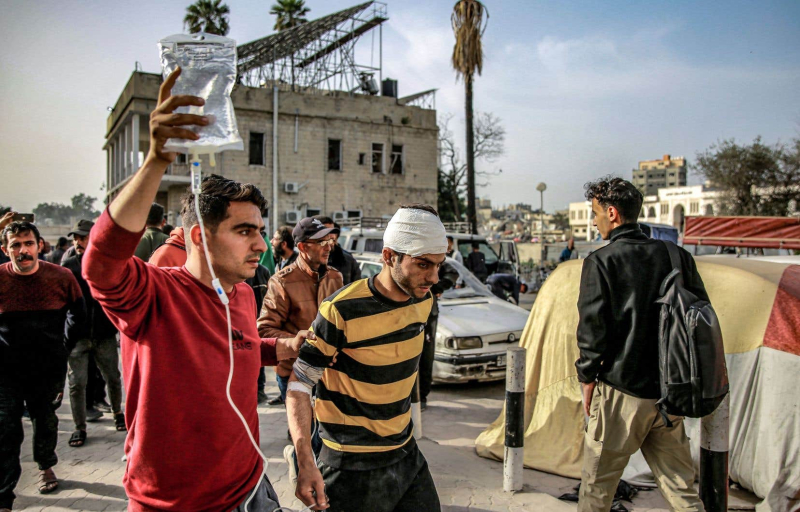
Photo: Agence France-Presse A Palestinian man carries an injured man's intravenous solution outside Ahli Arab Hospital on Thursday in the Gaza Strip.
Adel Zaanoun – Agence France-Presse and Benoît Finck – Agence France-Presse respectively in the Gaza Strip and Jerusalem
06:48
- Middle East
The Gaza Strip is the scene of air raids and fighting between the Israeli army and Hamas on Thursday at a time when Israel is reopening the door to discussions with Washington, against a backdrop of tensions with its Allied on an offensive at Rafah.
Early Thursday, the Hamas health ministry reported at least 66 deaths in Gaza overnight, including in airstrikes, while a senior local official reported fighting near Gaza City and in Khan Younes. At the same time, the Palestinian news agency Wafa reported clashes in various locations in the occupied West Bank.
The Israeli army, which accuses Hamas fighters of hiding in hospitals, continues its operation launched on March 18 in the al-Chifa hospital complex in Gaza City. In Khan Younes, soldiers are carrying out operations in the area of the Nasser and al-Amal hospitals, approximately one kilometer apart, as well as in the al-Qarara area.
The army said in a statement on Thursday that it had “eliminated around 200 terrorists in the area of the” al-Chifa hospital since the start of operations. Israeli soldiers came under fire “over the past day, from inside and outside the building housing the emergency room of al-Chifa hospital,” the same source added.< /p>
Israeli troops “evacuated civilians, patients and medical teams to alternative medical facilities set up by the army to allow appropriate medical treatment to continue,” the army assured.
Al-Amal Hospital “has stopped functioning completely,” the Palestinian Red Crescent said earlier this week after civilians there were evacuated. The Israeli army said Thursday that it had “eliminated dozens of terrorists in the al-Amal area” where its troops “found explosive devices and mortar shells”.
After Gaza City and Khan Younes, Israel wants to continue its ground offensive to this city at the southern tip of the Gaza Strip, which it considers to be the last major bastion of Hamas, and where 1.5 million people are crowded together. Palestinians, the vast majority displaced by violence elsewhere in the territory.
Israel's first ally, the United States fears the human toll of such an operation and prefers other options such as targeted operations against local Hamas leaders.
The Israeli government expressed its anger after the abstention of the American ally, which allowed the recent adoption of a resolution at the UN demanding an “immediate ceasefire”, and had canceled the sending of a delegation to Washington to discuss the planned ground offensive in Rafah.
But on Wednesday, a senior U.S. official said that Mr. Netanyahu's office had “expressed that they would like to find a new date to hold the Rafah meeting.”
At the same time, Qatar – which plays the role of mediator with Egypt and the United States – this week ensured the continuation of indirect negotiations between Israel and Hamas aimed at achieving a truce lasting several weeks in the fighting coupled with an exchange of Israeli hostages and Palestinian prisoners.
Also read
- Intense bombardments on Gaza, the army continues its operations around hospitals
- Hamas calls for stopping humanitarian aid drops
- Israel furious after US abstention at the UN
For humanitarian aid, “we must use the roads”
The war was sparked on October 7 by an unprecedented attack by the Palestinian Islamist movement Hamas against Israel which resulted in the deaths of at least 1,160 people, mainly civilians, according to an AFP count established from official Israeli data.
According to Israel, around 250 people have been kidnapped and 130 of them are still hostages in Gaza, of whom 34 are believed to have died.
In retaliation, Israel vowed to “destroy” Hamas — which it considers a terrorist organization along with the United States and the European Union — and launched a vast operation that left 32,552 people dead, mostly women. and minors, according to the Hamas Ministry of Health.
In addition to the heavy human toll and colossal destruction, the war has caused a humanitarian catastrophe in the cramped Palestinian territory, where the majority of the 2.4 million inhabitants are threatened with famine according to the UN.
While humanitarian aid by land, strictly controlled by Israel, arrives in trickles, several Arab and Western countries parachute food daily, especially in the north of the Gaza Strip where the situation is particularly desperate.
“Food aid is usually parachuted when people are isolated, hundreds of kilometers from anywhere. Here, the help you need is barely a few kilometers away: you have to use the roads! said James Elder, spokesperson for UNICEF, from Rafah.
On Tuesday, Hamas announced the death of 18 people, including 12 drowned while trying to recover airdropped food that had fallen into the sea, calling for an end to airdrops and the opening of land access to the delivery of aid.
“When the parachutes fell into the water, young men and boys began wading toward them. Unfortunately some did not return,” Ouday Nassar, a witness to the tragedy, told AFP.

